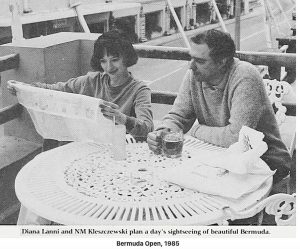By Matthew Grinberg, Founder of Alamogordo Chess Club

There has been a lot of talk recently about the possibility that Diana Lanni was Walter Tevis‘ inspiration for Beth Harmon in The Queen’s Gambit


This is what is known:
- Lanni and Tevis were both playing chess in the same circles in New York City in the 1970’s.
- Like Beth Harmon, Diana Lanni became intrigued with chess at a young age.
- Both had difficulties in their childhood.
- Both became chess masters at a young age and travelled to Europe to play.
In addition, Lanni had her greatest success as a player in the around 1980, when she twice played in the US Women’s Championship and was selected for the USA Women’s Team at the 1982 Olympiad. This was at the same time Tevis was writing “The Queen’s Gambit,” which was published in 1983.
See our podcast guest 2 time USA Women’s Champion, Jennifer Shahade’s interview with Diana Lanni on the subject here.
All this inspired me to look up Lanni’s games from the 1982 Olympiad and annotate one. In the following game Lanni goes for a blitzkrieg in the opening, then masterfully brings home the win in the resulting rook endgame:
Lanni, Diana (USA) – Maya De Alzate, Gloria (Columbia), 1-0
Women’s Olympiad, Round 10
Lucerne Switzerland, 10/1982
- e4 e5 2. Nf3 d6 Philidor’s Defense – not very enterprising since it blocks Black’s king bishop, but solid. 3. d4 Nf6 4. dxe5 Nxe4 5. Bc4
[More common is 5. Qd5 Nc5 6. Bg5 Be7 7. exd6 Qxd6 8. Nc3 White’s pieces are more active]
5… c6 6. O-O Be7
[Again, more common is 6… d5 7. Bd3 Nc5 8. Be2=]
- Nbd2
[In the following game White plays for an attack on the kingside, like Diana Lanni, but it doesn’t work out so well. 7. e6?! fxe6 8. Re1 d5 9. Bd3 Nc5 10. Ne5 O-O 11. Bxh7? Kxh7 12. Qh5 Kg8 13. Re3 Rf5 14. Qh3 Bh4 15. g3 Bf6 16. Ng6 d4 17. Re1 Nba6 18. g4 Rd5 19. a3 Bd7 20. f4 Qe8 21. f5 e5 22. g5? Qxg6 23. fxg6 Bxh3 24. c4 Rd6 25. b4? Nd3 26. Rd1 Nxc1 0-1, Boshnakov, Simeon – Chuchelov, Vladimir (BEL) 2554, Teteven 1991 It (open)]
7… Nxd2 8. Bxd2 O-O?!
[It is better for Black to secure her center before deciding what to do with her king. 8… d5=]
- Re1?! But White misses her opportunity.
[With better development, White should open up the game. 9. exd6 Qxd6 10. Re1 Nd7 11. Bg5 Qxd1 12. Raxd1 White’s more active pieces give her the better game]
9… d5 Better late than never. 10. Bd3 She aims her bishop at h7 setting up the potential for the Greek Gift – 11. Bxh7+ Kxh7, 12. Ng5+ but right now the combination would not work because of 12… Bxg5, 13. Qh5+ Bh6. 10… Bg4 Though the pin on the knight looks good, by setting the bishop out there undefended, the Greek Gift becomes a more legitimate possibility. Black correctly sees that the combination still doesn’t work and is trying to goad Lanni into playing it. 11. h3 White encourages the bishop to drop back to h5, so that if she plays the combination her queen will capture the bishop with check. 11… Bh5 12. Qe2! This subtle move sets up a position where the sacrifice is a real threat.
[The immediate sacrifice still doesn’t work 12. Bxh7? because after 12… Kxh7 13. Ng5 Kg6! The king defends the bishop! White is down a bishop and her queen and knight are both hanging. She has no good way to follow up the attack in spite of the exposed position of Black’s king]
12… Nd7
- Bxh7?! The Geek Gift – objectively not the best move, but very enterprising! Diana is confident she will overcome her opponent in the complications.
[A solid alternative is 13. b4 to restrain Black’s position]
13… Kxh7 14. Ng5 Bxg5
[Not 14… Kg6??? as in the note to White’s 12th move, because of 15. Qd3! This was the point of 12. Qe2. 15… f5 16. exf6 Kxf6 17. Re6#]
- Qxh5 Bh6 16. g4 Re8?! Black misses her chance to punish White for the premature sacrifice.
[What’s happening on the h-file is more important than what is happening on the e-file. 16… Rh8! 17. Qf5 (17. g5? g6 18. Qxh6 Kg8 White’s queen is trapped! 19. e6 Rxh6 20. exd7 Rxh3 21. Re8 Qxe8 22. dxe8=Q Rxe8 Black wins) 17… g6 18. Qxf7 Bg7 19. e6 Nc5 20. Bb4 Ne4 21. Kg2 Qf6 22. Qxf6 Nxf6 23. Rad1 Rae8 White does not have enough for being down a knight for two pawns]
- Bxh6 gxh6 18. Qxf7 Kh8 19. e6 Qf6? After this mistake, White just ends up with an extra pawn.
[Better is 19… Re7! 20. Qh5 Nc5 21. Qxh6 Rh7 22. Qf4 Qf8 23. Qe5 Qg7 24. Qxg7 Kxg7 25. Re3 Kf6 26. Rae1 Re7 27. b4 Nxe6 28. Re5 White is down a knight for two pawns, but her three connected passed pawns make the position unclear]
- Qxd7 Re7 21. Qd6 Rae8 22. Qe5!? Good enough to maintain the advantage…
[but 22. Re2! is even better. 22… Rxe6 23. Rae1!! Rxd6 24. Rxe8 Kg7 25. R1e7 Qf7 26. Rxf7 Kxf7 27. Ra8 Unlike in the game continuation, White ends up in a pawn up rook endgame with her rook deep in Black’s territory]
22… Kg7 23. f4 Qxe5 24. Rxe5 Rxe6 25. Rxe6 Rxe6 After all the complications that started with the Greek Gift on move 13, the dust has finally settled. White has a pawn advantage and a protected passed pawn on f4. Black has some chances because she has control of the only open file with his rook. But Diana Lanni plays the endgame very methodically to bring home the point.
- Kf2 Re4 27. Kf3 Kf6 28. Rd1 a5 29. Rd3 Rc4!? She shouldn’t give up the open file. One of the most important principles in rook endgames, both on offense and defense, is to keep your rook active.
[29… Re1 30. Rb3 Rf1 31. Kg3 Rc1 32. Rxb7 Rxc2 In spite of White’s menacing kingside pawns, Black’s passed d-pawn gives her chances to hold]
- c3 Re4 31. Re3 Ra4
[Trading rooks would give White an easy win in the pawn endgame. 31… Rxe3? 32. Kxe3 c5 33. a4 White wins]
- a3 b5?! When you are down in material in the endgame, it is important to trade off pawns, but this line is too slow.
[32… d4 immediately forces an exchange and reactivates her rook. 33. cxd4 (Or 33. Rd3 dxc3 34. Rxc3 Rd4 Black has drawing chances) 33… Rxd4 Black has drawing chances]
Now it becomes a slow grind with Lanni using her extra pawn and superior rook to force the win. 33. h4 b4 34. f5 c5 35. axb4 axb4 36. Re6 Kg7 37. Rg6 Kh7 38. Rd6 bxc3 39. bxc3 Ra3 40. Rxd5 Rxc3 41. Kf4 Rh3? She hopes to induce White into taking the c-pawn, which would likely end in a draw.
[A better try is 41… Rc4 though White still wins after 42. Kf3 Rc3 43. Kf2 Rc2 44. Ke3 c4 45. g5]
- Rd7! Sorry!
[42. Rxc5? Rxh4 43. Kg3 Rh1 44. Rc7 Kg8 White will have a hard time making progress with both her king and her g-pawn exposed to attack from Black’s rook]
42… Kg8 43. h5 c4 44. f6 c3 45. Rc7 Rd3
- g5! This is much better than immediately advancing the king.
[46. Kf5?! Rd5 Though 47. Ke6 still wins. (47. Kg6?? Rg5 48. Kxh6 Rxg4 49. Rxc3 Kf7 Black should draw)]
46… hxg5 47. Kf5! Black sees the inevitable and resigns. White’s king will use the Black g-pawn as a shield to drop his king into g6 for the final attack. […]
[47… Rd8 Black drops her rook back to stop the quick mate, but she can’t stop White from queening a pawn. 48. Kg6 Kh8 49. Rh7 Kg8 50. f7 Kf8 51. Rh8 Ke7 52. Rxd8 Kxd8 53. f8=Q White wins]
[1:0]
This was an intriguing game displaying quite different aspects of Lanni’s chess mastery.


Join our vibrant community of players and take part in thrilling tournaments, exciting promotions, and exclusive events.
Endless excitement and big wins await you here!
<a href="[Link deleted]is a perfect game for short bursts of adrenaline-pumping fun. Play a quick round on your lunch break or commute.
Test your skills on different difficulty levels in Slope. Start slow and work your way up to become a shredding master.
Diana Lanni’s journey is truly fascinating, and it’s interesting to see potential inspirations behind fictional characters like Beth Harmon. If you’re looking to explore more about chess history or need well-researched content, you can buy an essay at writology!
Listening to the interview between Jennifer Shahade and Diana Lanni really opens up a lot of insight into the pioneering women in chess at that time.
Agradezco el esfuerzo que dedicaste a este artículo. Siempre es bueno encontrar contenido original y reflexivo.
This service consistently delivers exceptional results with professionalism and attention to detail that exceeds expectations every time.구글찌라시 With a focus on precision and client goals, this team provides solutions that are both effective and sustainable.
Expertise combined with a client-focused mindset ensures every project is handled with care and delivers measurable success.강남쩜오 Choosing this service means investing in quality, reliability, and a team that truly understands your goals.
Thank you for providing such excellent information. Your website has a clean, professional feel, and I truly appreciate the depth of knowledge shared here. It’s clear that you have a strong understanding of the subject, which makes the content both insightful and engaging. I’ve bookmarked this page to revisit and look forward to exploring more of your articles. The way you present complex ideas in a clear and helpful manner is impressive and keeps readers wanting to return.